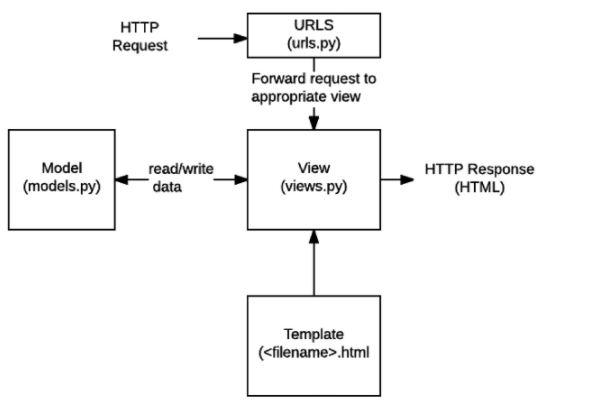Django란?
-
Dynamic Web Web Application Program
- static web : 미리 저장된 정적파일(HTML, CSS, JS)를 제공
- Dyanamic Web :server에서 request을 처리해서 client에게 response를 보내주게 됨
-
Python web framework
- web framework: 웹페이지를 개발하는 과정에서 겪는 어려움을 줄이는 것이 주 목적
- 가게를 창업할 때 스스로 다 하는 것과 프랜차이즈로 창업하는 것 정도의 차이
- 기본적인 구조나 필요한 코드는 알아서 제공, 좋은 웹 서비스 만드는 것에 집중 가능
-
어느 기업에서 쓰는가?
- spotify
- dropbox
- delivery hero
-
구조
-
MVC(model view controller) 소프트웨어 디자인 패턴
MTV(model template view) 같은 의미지만 django에서는 다르게 씀
- 데이터 베이스 관리 : Model
- 응용프로그램의 데이터 구조를 정의하고 데이터베이스의 기록을 관리(추가, 수정, 삭제)
- 레이아웃(화면) : Template
- 파일의 구조나 레이아웃을 정의
- 실제 내용을 보여주는 데 사용 (presentation)
- 중심 컨트롤러(심장) : View
- HTTP 요청을 수신하고 HTTP 응답을 반환
- Model을 통해 요청을 충족시키는데 필요한 데이터에 접근
- 그리고 탬플릿에게 응답의 서식 설정을 맡김
- 데이터 베이스 관리 : Model
-
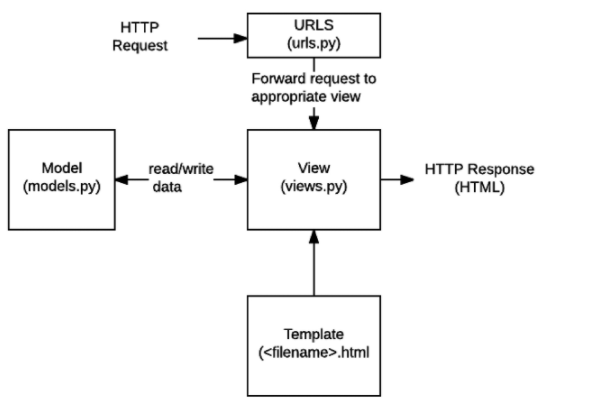
Django 설치
- pip
pip install django- 프로젝트 만들 공간위치로 cmd 열기 - 플젝생성
- 플젝이름에는 python키워드(라이브러리 이름들, 함수명 등)와 하이픈을 쓰면 안됨
- 하이픈은 언더바로 대체해서 쓸것
- 만약 현재 위치에 바로 생성하고 싶다면 맨 뒤에 . 추가
- 하단 폴더 안내려가고 바로 생성됨
- 플젝명이 아니라 config 로 할 경우도 있음
- 플젝이름에는 python키워드(라이브러리 이름들, 함수명 등)와 하이픈을 쓰면 안됨
django-admin startproject 플젝이름
django-admin startproject 플젝이름 . - 플젝 폴더에 하나 더 들어가면 플젝이름폴더, manage.py가 보임
- 여기서 cmd 열기 - 서버 켜기
- 끄고 싶으면 ctrl+c
python manage.py runserver
- (참고)runserver의 Automatic reloading
- 개발 서버는 요청이 들어올 때마다(코드가 저장될 때 마다) 자동으로 Python 코드를 다시 불러온다.
- 코드의 변경사항을 반영하기 위해서 굳이 서버를 재가동 하지 않아도 된다.
- 그러나, 파일을 추가하는 등의 몇몇의 동작(커스텀 필터, 새로운 모듈 추가 등)은 개발 서버가 자동으로 인식하지 못하기 때문에, 이런 상황에서는 서버를 재가동 해야 적용되는 경우도 있다.
VScode Django 추가 설치
-
django extension
- ctrl + shift + p → json검색 → Preferences: Open Settings (JSON) 선택
- 추가 코드 작성
// settings.json { ... 생략 ..., // Django "files.associations": { "**/*.html": "html", "**/templates/**/*.html": "django-html", "**/templates/**/*": "django-txt", "**/requirements{/**,*}.{txt,in}": "pip-requirements" }, "emmet.includeLanguages": { "django-html": "html" } } -
pylance
- Article.ojbects.get(pk=pk) 할떄 Article에 밑줄그어지는거 사라지게 할 수 있음
Django 프로젝트 폴더의 구성
__init__.py- 아무것도 안쓰여있음
- 파이썬 2.x 대 버전과의 호환을 위해 만들어진 비어있는 파일입니다.
- 파이썬 3.x 대 버전에서는 불필요하지만, 계속 생성 되어지는 파일입니다.
- 이 프로젝트 디렉토리를 하나의 패키지로 인식하게 해주는 기능
- 아무것도 안쓰여있음
asgi.py- 비동기 웹서버 연동에 사용됨
setting.py- django 설정
- Application 등록, file들의 위치, 데이터베이스의 세부사항, 보안에 관련된 것들 등등
- 맨 하단의 Internationalization 수정해주기
LANGUAGE_CODE = 'ko-kr': 한글로 번역이 되어서 나옴TIME_ZONE = 'Asia/Seoul': 데이터베이스 연동시간 서울표준시간으로
urls.py- client요청을 가장 먼저 받는 곳
- url 내부 연결을 지정해주는 역할(주소 관리)
wsgi.py- 배포할 때 사용함
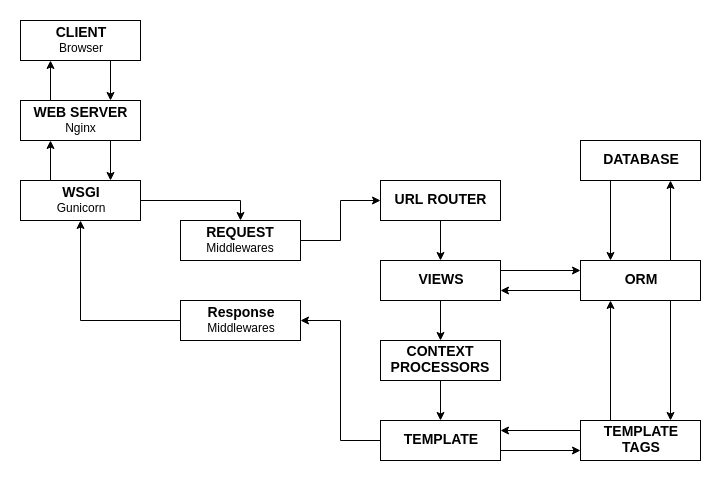
Settings.py
-
BASE_DIR
프로젝트 루트 폴더, 설정 파일이나 py 파일 등에서 프로젝트 루트 폴더를 찾아 그 하위를 탐색하거나 하는 일을 수행합니다.
-
SECRET_KEY
-
보안을 위해 사용 됩니다.
-
세션값의 보호나 비밀번호 변경시 사용되는 보안 URL을 만드는 일 등에 사용
-
-
DEBUG
- 디버그 모드를 설정합니다.
- True 일 경우 다양한 오류 메시지를 즉시 확인 할 수 있습니다.
- 실제 어플리케이션 배포 시에는 False로 바꿉니다.
-
ALLOWED_HOSTS
- 현재 서비스의 호스트를 정합니다.
- 실제 도메인을 기록합니다. (개발시에는 비워두기..)
- Debug 모드가 False일 때, ALLOWED_HOSTS가 비어있으면 서비스를 시작 할 수 없습니다.
-
INSTALLED_APPS
- 장고 웹 서비스는 다양한 앱의 결합으로 만들어 집니다.
- 현재 프로젝트에서 사용하는 앱의 목록을 기록하고 관리합니다.
- 작성하고 추가 할 앱 또한 이곳에 추가 해 주어야 합니다.
-
MIDDLEWARE
- 장고의 모든 요청/응답 메시지 사이에 실행되는 특수한 프레임워크들입니다.
- 주로 보안에 관한 내용들이 많습니다.
-
ROOT_URLCONF
-
기준이 되는 urls.py의 경로를 설정합니다.
-
TEMPLATES
- 장고에서 사용하는 템플릿 시스템에 관한 설정들입니다.
- 템플릿 해석 엔진과 폴더의 경로 등을 변경하는데 사용됩니다.
-
WSGI_APPLICATION
- wsgi 어필리케이션을 설정합니다.
-
DATABASES
- DB 관련 설정입니다.
-
AUTH_PASSWORD_VALIDATORS
- 비밀번호 검증을 위한 설정입니다. 기본적인 검증 로직이 들어있습니다.
-
LANGUAGE_CODE
- 다국어에 관한 설정.
요청과 응답
urls.py
-
장고 서버로 요청(request)이 들어오면, 그 요청이 어디로 가야하는지 인식하고 관련된 함수(view)로 넘겨준다.
-
views.py에서 만든 함수를 연결시켜준다.# first_project/urls.py from django.contrib import admin from django.urls import path from articles import views urlpatterns = [ path('admin/', admin.site.urls), path('index/', views.index), ]
views.py
- HTTP 요청을 수신하고 HTTP 응답을 반환하는 함수 작성
- Model을 통해 요청에 맞는 필요 데이터에 접근
- tempate에게 HTTP 응답 서식을 맡김
# articles/views.py
def index(request): # 첫번째 인자는 반드시 request
return render(request, 'index.html') # render의 첫번째 인자도 반드시 requestTemplates**
-
views.py에서 지정한index.html파일을 만들자. -
Django에서 template이라고 부르는 HTML 파일은 기본적으로 app 폴더안의 templates 폴더 안에 위치한다.
<!-- articles/templates/index.html --> <h1>만나서 반갑습니다!</h1>
장고 기본 명령들
- django-admin startproject : 장고 프로젝트를 만드는 명력. 웹 서비스를 만들 때 마다 한번 실행합니다.
- startapp : 프로젝트에 기능 단위인 앱을 새로 만들 때 사용
- makemigrations : 어플리케이션에 변경 사항을 추적해 DB에 적용 할 내용을 정리합니다. 앱 안의 모델에 변경 사항이 존재할 때 사용
- sqlmigrate : 실행 할 SQL 명령문을 출력합니다.
- migrate: 실제 변경사항을 DB에 반영합니다.
- showmigrations : 프로젝트의 DB 변경사항 목록과 상태를 출력합니다.
- runserver : 테스트 서버를 실행합니다. 웹 서비스를 실제로 동작 시켜 확인합니다.
- dumpdata : 현재 DB의 내용을 백업할때 사용
- loaddata : 백업 파일에서 DB로 내용을 복구 할 때 사용합니다.
- flush : DB 테이블은 그대로 두고 테이블의 내용만 전부 삭제
- shell : 장고 쉘을 실행합니다. 작성한 모델 등을 불러 와 실제로 테스트 해 볼 수있습니다.
- dbshell : DB에 직접 접근 할 수 있는 쉘을 실행합니다. 장고 관리자에 문제가 있을 때 주로 dbshell을 통해 DB를 수정
- createsuperuser : 관리자 계정을 생성
- changepassword : 계정의 비밀번호를 변경 할 수 있습니다.
Application
- 사이트가 기능적인 측면을 하기 위해서는 프로젝트가 하지는 않음
- 어플리케이션이 실제 기능을 구동함
만드는법
- 생성하면 django프로젝트폴더 위치에 어플리케이션 폴더가 하나 생김
- 하단 명령어로 꼭 생성 후, settings 에 등록할것
python manage.py startapp 어플리케이션이름Application 폴더의 구성
__init__.py- 아무것도 안쓰여있음
- 이 프로젝트 디렉토리를 하나의 패키지로 인식하게 해주는 기능
admin.py- 관리자 역할을 관리
- 자신이 만든 모델을 관리자 페이지에서 확인하거나 특별한 기능을 추가할 수 있음,
apps.py- 수업끝날 때 까지 건들이지 않음
models.py- MTV의 model역할
- django는 이 모델을 이용해 DB의 종류에 상관 없이, SQL을 잘 모르더라도 DB를 편하게 이용 할 수 있도록 ORM을 사용합니다.
test.py- 테스트 하는데 쓰이는 곳
views.py- MTV의 veiw 역할
- 페이지 관리(페이지 하나당, 하나의 함수)
- (개별생성)
urls.py- "어떤 url"을 이용해 "어떤 view"를 동작 시킬까를 결정 해야 하는 것을 결정 해 주는 파일
- (개별생성)templates
- 보통 HTML이 들어있는 파일입니다. 대부분 html 의 확장자를 가지고 있지만, html이 아닌 템플릿 코드들도 들어있습니다.
프로젝트에 application 등록하기
-
프로젝트.settings.py열기-
INSTALLED_APPS = [ ... ]-
이곳에 맨 상단에
application이름을 적기 -
보통 application의 적는 순서는 이렇게 구성됨
- local apps
- 3rd-party apps
- django apps
-
보게되면 리스트 맨 뒤에 요소 뒤에
,가 붙은 것을 확인할 수 있음(trailing comma)django에서 권장되는 문법임
-
-
실험하면서 작동과정 체험해보기
페이지 연동시켜보기
프로젝트폴더.urls.py
urlpatterns = [
path('admin/', admin.site.urls),
# path 첫번째 인자 : 연결시킬 주소
# path 두번째 인자 : 어떤 View(application.함수명)를 연결시킬 것이냐
]- 연결시킬 View :
Application이름.views.py- app 이름은 복수형으로 만들자
- 사용하다보면 app의 단수형 이름 class를 사용할 경우가 생겨 혼동 생기는 것을 막기 위해 복수형으로 만드는 것이 좋다
- app 이름은 복수형으로 만들자
def index(request) : # view함수의 첫번째 인자는 request이어야함
return render(request, '템플릿경로')
# 랜더링의 첫번째 인자도 request이어야함
# 두번째 인자는 template 경로- 다시
프로젝트폴더.urls.py
from articles import views # application의 view를 import 시키기
urlpatterns = [
path('admin/', admin.site.urls),
path('index/', views.index), # 방금 만든 views의 함수를 연동시킴
]- 템플릿 만들기
application폴더내부에templates폴더 생성- 폴더 안에 html 파일(예시 : index.html) 만들어주기
- View에 템플릿 등록하기
def index(request) : # view함수의 첫번째 인자는 request이어야함
return render(request, 'index.html') # 템플릿경로 작성Template
- 데이터 표현을 제어하는 도구이자 표현에 관련된 로직
- 사용하는 built-in system
- Django template language
Django template language(DTL)
- django template에서 사용하는 built-in template system
- 조건, 반복, 변수 치환, 필터 등의 기능을 제공
- 단순히 python이 HTML에 포함된 것이 아니며
- 프로그래밍적 로직이 아니라 프레젠테이션을 표현하기 위한 것
- 파이썬처럼 일부 프로그래밍 구조(if, for)를 사용할 수 있지만, 이것은 해당 python코드로 실행되는 것이 아님
DTL Syntax
- 참고
- Django Template Language(DTL)
- Built-in template tags and filter
Variable
{{ 변수명 }}- render()를 사용하여 views.py에서 정의한 변수를 template 파일로 넘겨 사용하는 것
- 변수명은 영어, 숫자와 밑줄(_)의 조합으로 구성될 수 있으나, 밑줄로는 시작할 수없음
- 공백이나 구두점 문자 또한 사용할 수 없음
- dot(
.)을 사용하여 변수 속성에 접근할 수 있음 - render()의 세번째 인자로 {'key': value}와 같이 딕셔너리 형태로 넘겨주며, 여기서 정의한 key에 해당하는 문자열이 template 에서 사용 가능한 변수명이 됨.
Filters
{{ 변수명|filter }}{{ name|lower }}: name 변수를 모두 소문자로 출력
- 표시할 변수를 수정할 때 사용
- 60개의 built-in template filters를 제공
- chained가 가능하며 일부 필터는 인자를 받기도함
{{ 변수명|truncatewords:30 }}
Length filter
<h3> 3. Length filter </h3>
<p> {{students|length}} </p>
{% for fruit in fruits %}
{% if fruit|length > 3 %}
<p>{{fruit}} 과일 이름이 기네요? </p>
{% else %}
<p>{{fruit}} 과일 이름이 짧네요 </p>
{% endif %}
{% endfor %} 글자필터
<hr>
<h3> 5. 글자필터 </h3>
<p> {{ 'JIYOUNG'|lower}} </p>
<p> {{'ji young'|title}} </p>
<p> {{ students|random}} </p>
<br>연산
<hr>
<h3> 6. 연산 </h3>
<p> {{4|add:6}} </p> 날짜
<h3> 7. 날짜 </h3>
{% comment %} 현재시간을 여러 형태로 바꿔서 보여주기 {% endcomment %}
<p> {% now "DATETIME_FORMAT" %}</p><!-- 2021년 3월 9일 12:40 오후-->
<p> {% now "SHORT_DATETIME_FORMAT" %}</p><!--2021-3-9 12:40 -->
<p> {% now "DATE_FORMAT" %}</p><!--2021년 3월 9일 -->
<p> {% now "SHORT_DATE_FORMAT" %}</p><!-- 2021-3-9.-->
<p> {% now "Y년 m월 d일 h:i" %}</p> <!--2021년 03월 09일 12:40-->
<p> {% now "Y년 m월 d일 (D) A h:i" %} <!-- 2021년 03월 09일 (화요일) 오후 12:44-->
{% comment %} 출력결과를 변수로 저장해서 활용하기 {% endcomment %}
{% now "Y" as current_year %}
<p>{{ current_year}}</p><!-- 2021-->
Tags
{% tag %}- 출력 텍스트를 만들거나, 반복 또는 논리를 수행하여 제어 흐름을 만드는 등 변수보다 복잡한 일들을 수행
- 일부 태그는 시작과 종료 태그가 필요
{% tag %}...{% endtag %}
- 약 24개의 built-in template tags를 제공
for문
<h1>DTL 연습페이지</h1>
<hr>
<h3>1. for </h3>
<p> for 문 돌릴 것 : {{students}}</p>
{% for student in students%}
<p>{{student}}</p>
{% endfor %}
<br>
<p>for 문 인덱스사용하기 </p>
{% for fruit in fruits%}
<p>{{ forloop.counter }} {{fruit}} </p>
{% endfor %}
<br>
<p>for문 비어있을 경우</p>
{% for user in user_list %}
<p> {{ user }} </p>
{% empty %}
<p> 유저정보가 없습니다 </p>
{% endfor%}
<br>if 문
<hr>
<h3> 2. if </h3>
{% if '김지용' in students %}
<p> 반장있어요 </p>
{% else %}
<p> 반장없음 </p>
{% endif %}
<br>
{% for student in students %}
{% comment %} 루프에서 첫번째 이면 {% endcomment %}
{% if forloop.first %}
<p> 첫번째 학생은 {{student}}님 입니다. </p>
{% else %}
<p> {{stduent}} </p>
{% endif %}
{% endfor %}
<br>lorem
-
{% lorem [count] [method] [random] %}count생성 할 단락 또는 단어 수를 포함하는 숫자 (또는 변수)입니다 (기본값은 1). method어느 w단어에 대한pHTML 단락 또는b일반 텍스트 단락 블록 (기본값입니다b).randomrandom주어진 경우 단어 는 텍스트를 생성 할 때 공통 단락 ( "Lorem ipsum dolor sit amet…")을 사용하지 않습니다.
Comments
{# lorem ipsum #}- django template에서 줄의 주석을 표현하기 위해 사용
- 아래처럼 유효하지 않은 템플릿 코드가 포함될 수 있음
{# {% if .. % }text{% else %} #}
- 한줄 주석에만 사용할 수 있음( 줄바꿈이 허용되지 않음)
- 여러 줄 주석은
{% comment %}와{% endcomment %}사이에 입력
Template inheritance
- 템플릿 상속은 기본적으로 코드의 재사용성에 초점을 맞춤
- 템플릿 상속을 사용하면 사이트의 모든 공통요소를 포함하고, 하위 템플리이 재정의(override) 할 수 있는 블록을 정의하는 기본 "skeleton" 템플릿을 만들 수 있음
{% extends %}- 자식(하위)템플릿이 부모 템플릿을 확장한다는 것을 알림
- 반드시 템플릿 최상단 에 작성되어야함
- 즉, 2개 이상 사용할 수 없음
{% block %}- 하위 템플릿에서 재지정(overriden)할 수 있는 블록을 정의
- 즉, 하위 템플릿이 채울 수 있는 공간
- 가독성을 높이기 위해 선택적으로
{% endblock %}태그에 이름 지정
Base.html 만들기
-
base.html 하고 (위치 : 프로젝트/templates 폴더 만들고 안에)
- index.html 재정의 - 코드가 엄청 짧아짐(간결)
{% extends 'base.html' %} {% block content %} <h1> 만나서 반가워요 </h1> {% endblock %}
-
플젝.settings 에서 templates
-
app_dirs:True: 이거는 templates/ 경로를 생략해도 되는 이유- 템플릿 로더가 앱의 템플릿 디렉토리를 검색하여 템플릿을 찾습니다.
myapp/ templates/ blog/ list.html post.html
-
-
dirs: 여기에-
`[BASE_DIR / 'firstpjt' / 'templates'],
-
python pathlib
-
이렇게 사용시 os에 따른 경로표현(window는 역슬래쉬, mac은 슬래쉬)에 상관없이 경로 표현이 가능해짐
-
settings 상단에 찾아보면
BASE_DIR = Path(__file__).resolve().parent.parent이런게 있음의미는 현재 프로젝트 최상단 디렉토리 위치임
-
템플릿 로더는 먼저 《DIRS》 디렉토리에서 템플릿을 찾습니다.
-
-
Template의 Django 설계 철학
- 표현과 로직(view)을 분리
- 템플릿 시스템은 표현을 제어하는 도구이자 표현에 관련된 로직일 뿐이라고 생각
- 즉, 템플릿 시스템은 이러한 기본 목표를 넘어서는 기능을 지원하지 말아야 한다.
- 중복을 배제
- 대다수의 동적 웹사이트는 공통 header, footer, navbar 같은 사이트 공통 디자인을 갖는다.
- Django 템플릿 시스템은 이러한 요소를 한 곳에 저장하기 쉽게 하여 중복 코드를 없애야한다.
- 이것이 템플릿 상속의 기초가 되는 철학이다.
HTML form
- 웹에서 사용자 정보를 입력하는 여러 방식(text, button, checkbox, file, hidden, image, password, radio, reset, submit)을 제공하고, 사용자로부터 할당된 데이터를 서버로 전송하는 역할을 담당
- 핵심 속성
- action : 입력 데이터가 전송될 URL 지정
- method : 입력 데이터 전달 방식 지정
HTML input element
- 사용자로부터 데이터를 입력받기 위해 사용
- type속성에 따라 동작방식이 달라짐
- 핵심 속성
- name
- 중복가능, 양식을 제출했을 때 name이라는 이름에 설정된 값을 넘겨서 값을 가져올 수 있음
- 주요 용도는 GET/POST방식으로 서버에 전달하는 파라미터(name은 key, value는 value)로
?key=value&key=value형태로 전달
HTTP
- HyperTeext Transfer Protocol
- 웹에서 이루어지는 모든 데이터 교환의 기초
- 주어진 리소스가 수행 할 원하는 작업을 나타내는 request methods를 정의
- HTTP request method 종류
- GET, POST, PUT, DELETE ...
GET - HTTP request method
- 서버로부터 정보를 조회하는 데 사용
- 데이터를 가져올 떄만 사용해야함
- 데이터를 서버로 전송할 때 body가 아닌 Query String Parameters를 통해 전송
- 우리는 서버에 요청을 하면 HTML 문서 파일 한 장을 받는데 이 떄 사용하는 요청의 방식이 GET
실습 - 데이터 받아서 넘기는 페이지 만들기
-
첫번째 view = 데이터 받는 template
-
프로젝트.urls> urlpatterns 에path('throw/', views.throw),추가 -
어플리케이션.views에 throw 함수 추가def throw(request) : return render(request, 'throw.html') -
어플리케이션.templates에 throw.html 추가
{% extends 'base.html' %} {% block content %} <h1>THROW</h1> {% comment %} action은 어느 페이지로 넘겨줄지 {% endcomment %} <form action="/catch/" method="GET"> <label for="message">Throw: </label> <input type="text" name="message" id="message"> <input type="submit"> </form> {% endblock %} -
-
두번째 view - 보내준 데이터 받는 view
-
프로젝트.urls> urlpatterns 에path('catch/', views.catch),추가 -
어플리케이션.views에 throw 함수 추가def catch(request) : message = request.GET.get('message') # request 객체에서 GET 에서, throw에서 text input의 name = message context = { 'message' : message, } return render(request, 'catch.html', context)
-
-
어플리케이션.templates에 catch.html 추가{% extends 'base.html' %} {% block content %} <h1>{{message}}</h1> {% endblock %}
URL
-
Django URLs
- Dispatcher(발송자, 운항 관리자) 로서의 URL
- 웹 어플리케이션은 URL을 통한 클라이언트의 요청에서부터 시작 됨
App URL mapping
-
app의 view 함수가 많아지면서 사용하는 path() 또한 많아지고, app 또한 더 작성되기 때문에 프로젝트의 urls.py에서 모두 관리하는 것은 코드 유지보수에 좋지 않음
-
이제는 각 app에 urls.py를 작성하게 됨
-
원래 app에 urls.py는 없다.
-
근데 여러개의 app으로 구성될경우
프로젝트.settings에서 import 받을 때 충돌이 나겠지? 물론 as를 이용해서 각각 이름을 나눠줘도 되긴 하지만 복잡해짐-
어플리케이션.urls.pyfrom django.urls import path from . import views # django는 명시적인 경로 표현을 선호함 urlpatterns = [ # 원래 프로젝트.urls에 있던 것을 가져옴 - admin 제외 path('index/', views.index), path('greeting/', views.greeting), path('throw/', views.throw), path('catch/', views.catch), ] -
두번쨰어플리케이션.urls.pyfrom django.urls import path from . import views # django는 명시적인 경로 표현을 선호함 urlpatterns = [ # 두번째 어플리케이션 내부의 view를 연동 ] -
그럼 project의 urls는 아무런 역할을 안하냐?
그것은 아님
articles.urls로 갈지pages.urls로 갈지 판단하여 넘겨줌from django.contrib import admin from django.urls import path, include # app의 urls 로 넘기기 위해 include 추가 from articles import views urlpatterns = [ path('admin/', admin.site.urls), # path 첫번째 인자 : 연결시킬 주소 # path 두번째 인자 : 어떤 View(application.함수명)를 연결시킬 것이냐 path('articles/', include('articles.urls')), path('pages/', include('pages.urls')), ]
-
-
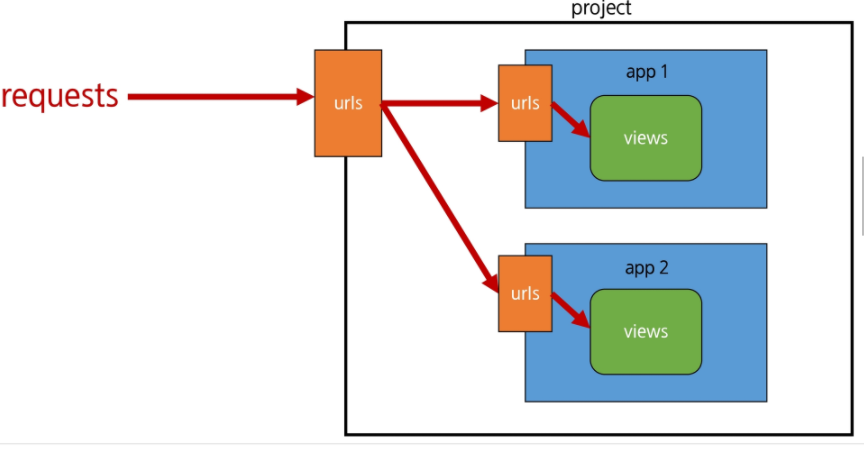
Variable routing (동적 라우팅)
-
주소 자체를 변수처럼 사용해서 동적으로 주소를 만드는 것
-
하는 법
urls
path('hello/<str:name>/', views.hello), # str: 은 기본값이라 생략가능, int나 다른 변수형은 명시해주어야함views.py
def hello(request, name) : # 주소로 넘겨받은 name변수값 context = { 'name' : name, } return render(request, 'hello.html', context)
Including other URLconfs
# firstpjt/urls.py
from django.contrib import admin
from django.urls import path, include
urlpatterns = [
path('admin/', admin.site.urls),
path('articles/', include('articles.urls')),
path('pages/', include('pages.urls')),
]include()
- 다른 URLconf(app1/urls.py)들을 참조할 수 있도록 도움
- 함수 include()를 만나게 되면, URL의 그 시점까지 일치하는 부분을 잘라내고, 남은 문자열 부분을 후속 처리를 위해 include된 URLconf로 전달
Naming URL patterns
- 이제는 링크에 url을 직접 작성하는 것이 아니라 path()함수의 name인자를 정의해서 사용
- Django Template Tag 중 하나인 url 태그를 사용해서 path() 함수에 작성한 name을 사용할 수 있음
- url 설정에 정의된 특정한 경로들의 의존성을 제거할 수 있음
path('index/', views.index, name='index')<a href="{% url 'index' %}">메인 페이지</a>-
{% url '' %}- 주어진 URL 패턴 이름 및 선택적 매개 변수와 일치하는 절대 경로 주소를 반환
- 템플릿에 URL을 하드 코딩하지 않고도 DRY 원칙을 위반하지 않고 링크를 출력하는 방법
Namespace
-
application이 많아질 경우 naming url 사용시 어떤 application과 연동된 페이지인지 알기가 힘들어짐
-
어플리케이션.templates안에어플리케이션이름폴더를 하나 더 만들고 그 안에 html 파일을 넣는 방식을 취함- Django는 기본적으로
app_name/templates/경로에 있는 templates 파일들만 찾을 수 있으며, INSTALLED_APPS에 작성한 app 순서로 tamplate을 검색 후 렌더링 - 임의로 templates의 폴더 구조를
app_name/templates/app_name형태로 변경해 임의로 이름 공간 생성 후 변경된 추가 경로 작성하는 것임
- Django는 기본적으로
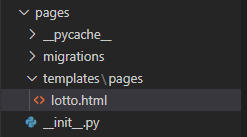
어플리케이션.urls에서 app_name 속성 활성화- URL namespace를 사용하면 서로 다른 앱에서 동일한 URL 이름을 사용하는 경우에도 이름이 지정된 URL을 고유하게 사용 할 수 있음
- urls.py에
app_nameattribute 값 작성
app_name = '어플리케이션이름'
urlpatterns = [
...
]-
view 단에서 연결시켜줄 때
어플리케이션/페이지이름.html로 접근def lotto(request) : now_lotto = random.sample(range(1:46), 7) context = { 'now_lotto6' : now_lotto[:6], } return render(request, 'pages/lotto.html', context) -
실제페이지에서 연동할 때
어플리케이션.urls.py > app_name의 속성에 의하여 연동됨{% url 'pages:lotto' %}와 같이 url 이후해당어플리케이션:페이지로 어느 어플리케이션에서 쓰는지 명시하면서 사용
